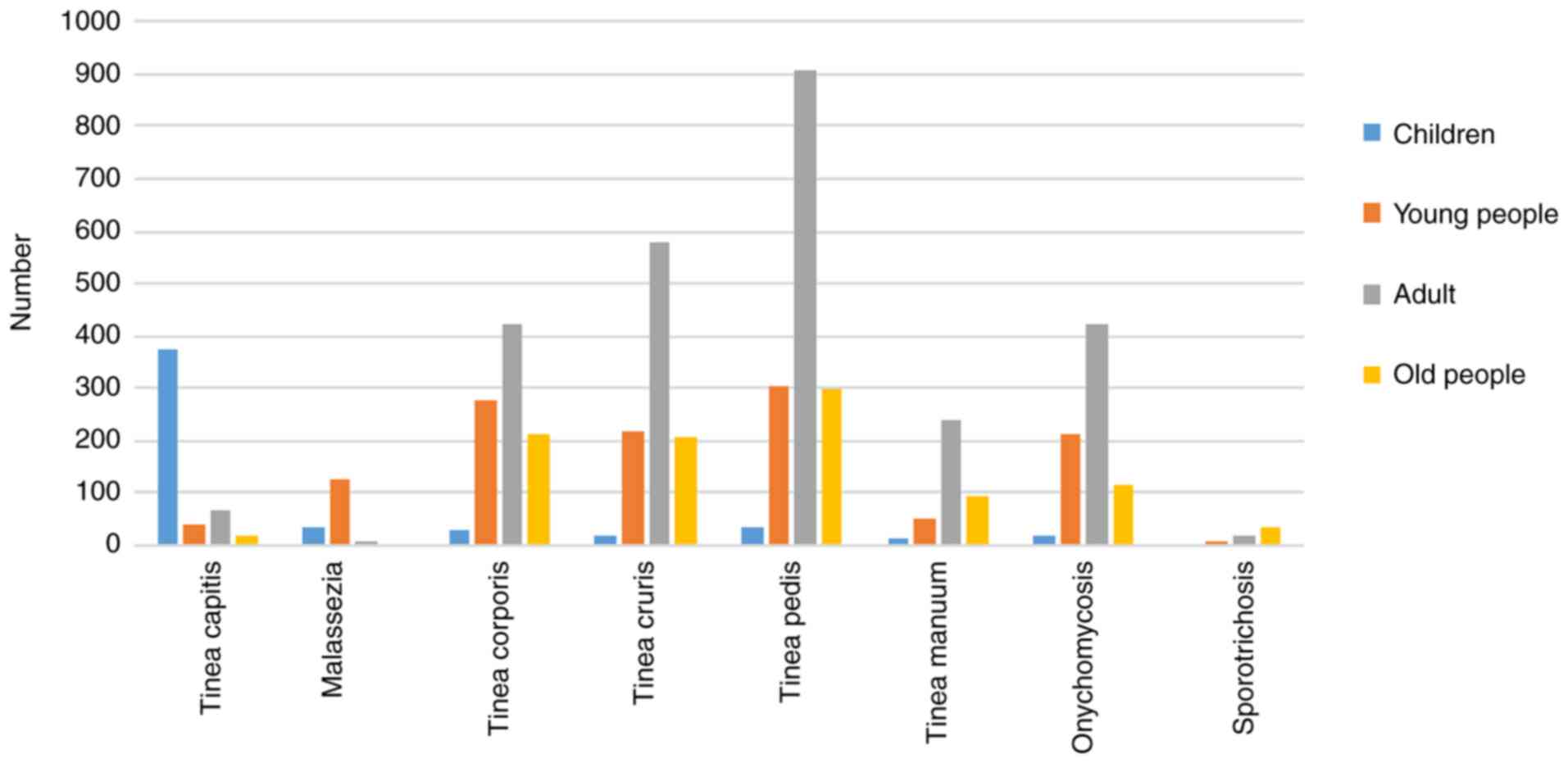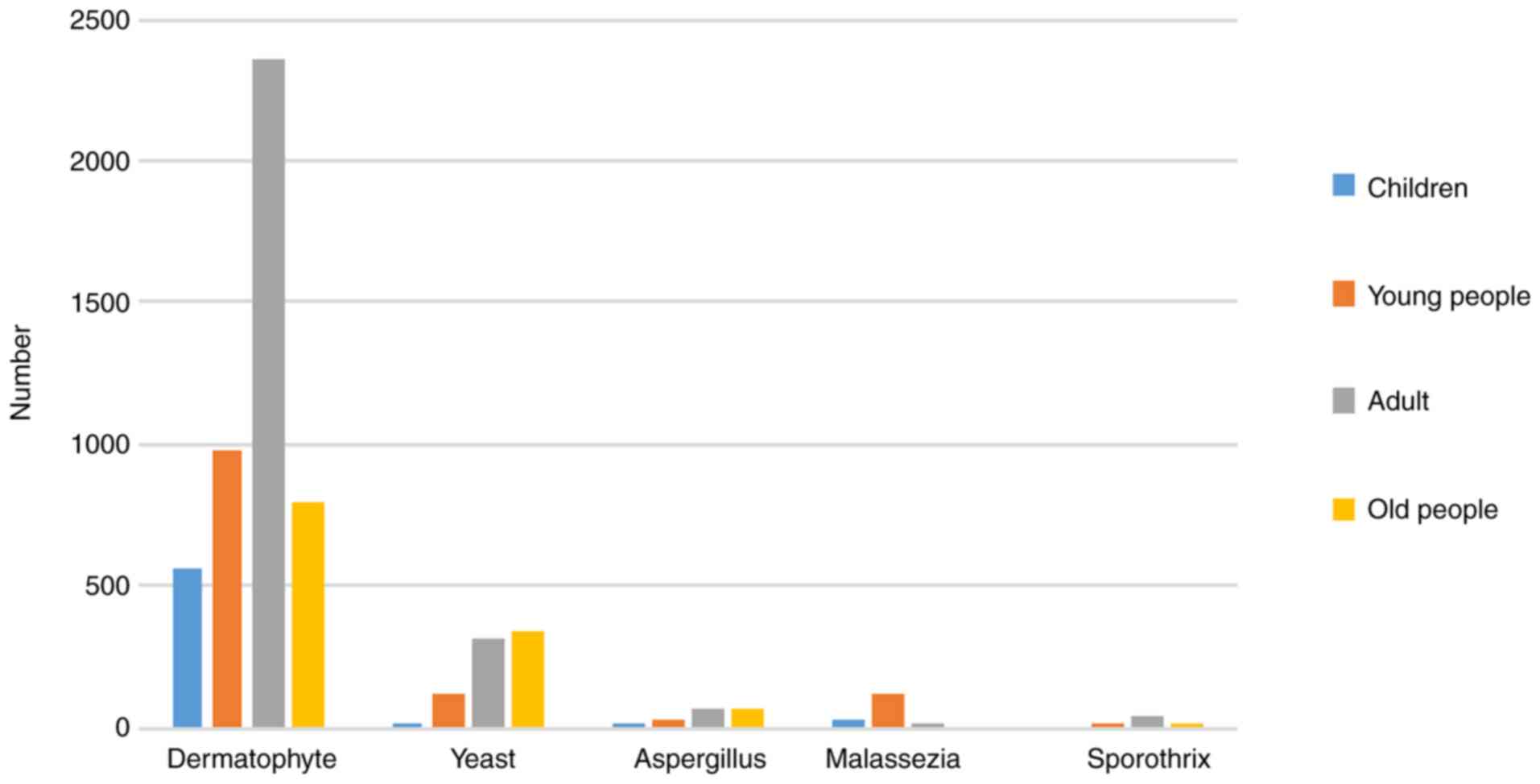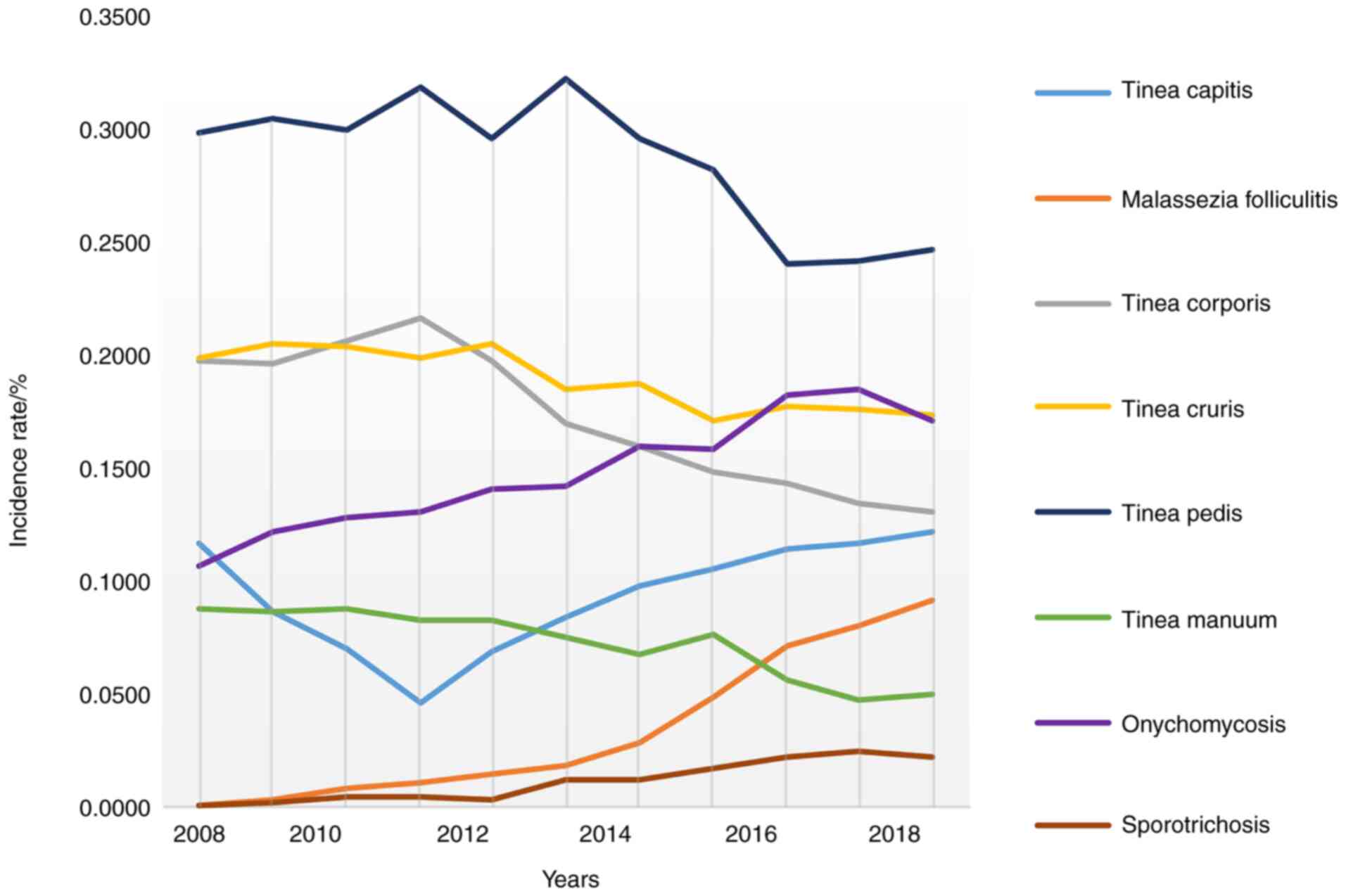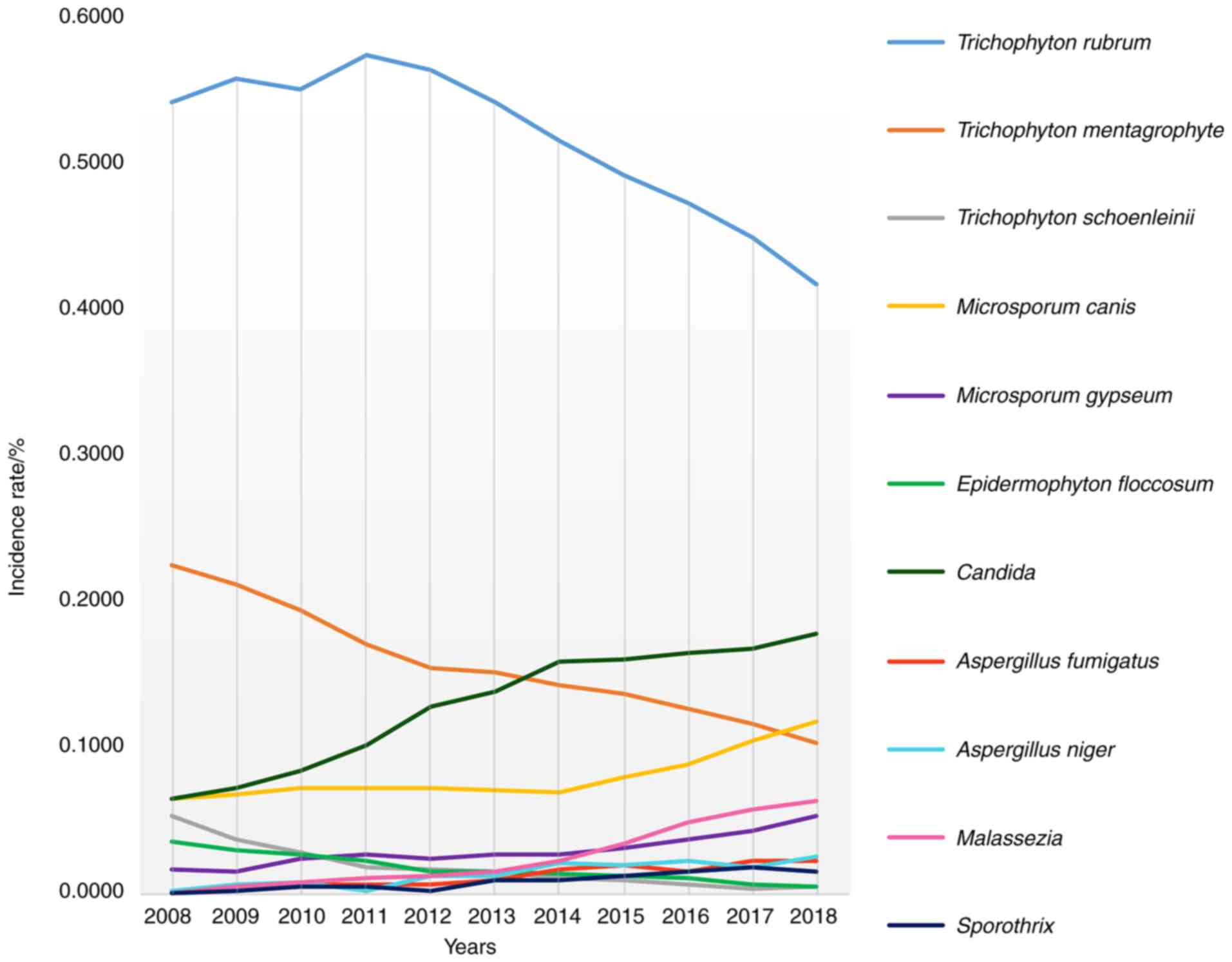|
1
|
Feng W, Chen C, Mo S, Qi C, Gong J, Li XN,
Zhou Q, Zhou Y, Li D, Lai Y, et al: Highly oxygenated
meroterpenoids from the Antarctic fungus Aspergillus
terreus. Phytochemistry. 164:184–191. 2019.PubMed/NCBI View Article : Google Scholar
|
|
2
|
Bezshapochny SB, Zachepilo SV, Polyanskaya
VP, Bobrova NA and Fedorchenko VI: Opportunistic mycoses of ENT
organs. Part 1. Vestn Otorinolaringol. 83:67–71. 2018.PubMed/NCBI View Article : Google Scholar : (In Russian).
|
|
3
|
Lao M, Wang X, Ding M, Yang Z, Chen H,
Liang L, Zhan Z and Chen D: Invasive fungal disease in patients
with systemic lupus erythematosus from Southern China: A
retrospective study. Lupus. 28:77–85. 2019.PubMed/NCBI View Article : Google Scholar
|
|
4
|
Upadhyay V, Kumar A, Singh AK and Pandey
J: Epidemiological characterization of dermatophytes at a tertiary
care hospital in Eastern Uttar Pradesh, India. Curr Med Mycol.
5:1–6. 2019.PubMed/NCBI View Article : Google Scholar
|
|
5
|
Moriello KA: Decontamination of 70 foster
family homes exposed to Microsporum canis infected cats: A
retrospective study. Vet Dermatol. 30:178–e55. 2019.PubMed/NCBI View Article : Google Scholar
|
|
6
|
Hilmioğlu-Polat S, Seyedmousavi S, Ilkit
M, Hedayati MT, Inci R, Tumbay E and Denning DW: Estimated burden
of serious human fungal diseases in Turkey. Mycoses. 62:22–31.
2019.PubMed/NCBI View Article : Google Scholar
|
|
7
|
Alvarez-Moreno CA and Combariza JF: Risk
of invasive fungal infections during hospital construction: How to
minimize its impact in immunocompromised patients. Curr Opin Infect
Dis. 32:322–329. 2019.PubMed/NCBI View Article : Google Scholar
|
|
8
|
Rouzaud C, Chosidow O, Brocard A, Fraitag
S, Scemla A, Anglicheau D, Bouaziz JD, Dupin N, Bougnoux ME, Hay R,
et al: Severe dermatophytosis in solid organ transplant recipients:
A French retrospective series and literature review. Transpl Infect
Dis: Feb 20, 2018 (Epub ahead of print). doi:
10.1111/tid.12799.
|
|
9
|
Deptuła A, Trejnowska E, Dubiel G,
Żukowski M, Misiewska-Kaczur A, Ozorowski T and Hryniewicz W:
Prevalence of healthcare-associated infections in Polish adult
intensive care units: Summary data from the ECDC European Point
Prevalence Survey of hospital-associated infections and
antimicrobial use in Poland 2012-2014. J Hosp Infect. 96:145–150.
2017.PubMed/NCBI View Article : Google Scholar
|
|
10
|
Nenoff P, Verma SB, Vasani R, Burmester A,
Hipler UC, Wittig F, Krüger C, Nenoff K, Wiegand C, Saraswat A, et
al: The current Indian epidemic of superficial dermatophytosis due
to Trichophyton mentagrophytes - A molecular study. Mycoses.
62:336–356. 2019.PubMed/NCBI View Article : Google Scholar
|
|
11
|
Otašević S, Momčilović S, Golubović M,
Ignjatović A, Rančić N, Đorđević M, Ranđelović M, Hay R and
Arsić-Arsenijević V: Species distribution and epidemiological
characteristics of superficial fungal infections in Southeastern
Serbia. Mycoses. 62:458–465. 2019.PubMed/NCBI View Article : Google Scholar
|
|
12
|
Dainton C and Chu CH: A narrative review
of dermatologic protocols for primary care medical service trips in
Latin America and the Caribbean. Int J Dermatol. 56:1425–143.
2017.PubMed/NCBI View Article : Google Scholar
|
|
13
|
Singh S, Ehsani-Chimeh N, Kornmehl H and
Armstrong AW: Quality of life among dermatology patients: A
systematic review of investigations using qualitative methods. G
Ital Dermatol Venereol. 154:72–78. 2019.PubMed/NCBI View Article : Google Scholar
|
|
14
|
Nilsson K, Friberg M, Rollman O and Tano
E: Impact of prolonged storage of clinical samples at 4˚C on the
recovery of dermatophytes by culture or PCR analysis. J Mycol Med.
29:1–6. 2019.PubMed/NCBI View Article : Google Scholar
|
|
15
|
Leung AKC, Leong KF and Lam JM: Tinea
imbricata: An overview. Curr Pediatr Rev. 15:170–174.
2019.PubMed/NCBI View Article : Google Scholar
|
|
16
|
Farag AGA, Hammam MA, Ibrahem RA, Mahfouz
RZ, Elnaidany NF, Qutubuddin M and Tolba RRE: Epidemiology of
dermatophyte infections among school children in Menoufia
Governorate, Egypt. Mycoses. 61:321–325. 2018.PubMed/NCBI View Article : Google Scholar
|
|
17
|
Gawdzik A, Nowogrodzka K,
Hryncewicz-Gwóźdź A, Maj J, Szepietowski J and Jankowska-Konsur A:
Epidemiology of dermatomycoses in southwest Poland. Postepy
Dermatol Alergol. 36:604–608. 2019.PubMed/NCBI View Article : Google Scholar
|
|
18
|
de Albuquerque Maranhão FC,
Oliveira-Júnior JB, Dos Santos Araújo MA and Silva DMW: Mycoses in
northeastern Brazil: Epidemiology and prevalence of fungal species
in 8 years of retrospective analysis in Alagoas. Braz J Microbiol.
50:969–978. 2019.PubMed/NCBI View Article : Google Scholar
|
|
19
|
Antuori A, Fernández G, Fernández A,
Alcaide M, Boada A, Bielsa MI, Romaní N and Matas L: Epidemiology
of dermatophytic infections between 2008 and 2017 in Barcelona,
Spain. Enferm Infecc Microbiol Clin. 37:642–647. 2019.PubMed/NCBI View Article : Google Scholar
|
|
20
|
Sen S, Borah SN, Kandimalla R, Bora A and
Deka S: Efficacy of a rhamnolipid biosurfactant to inhibit
Trichophyton rubrum in vitro and in a mice model of
dermatophytosis. Exp Dermatol. 28:601–608. 2019.PubMed/NCBI View Article : Google Scholar
|
|
21
|
Bitencourt TA, Oliveira FB, Sanches PR,
Rossi A and Martinez-Rossi NM: The prp4 kinase gene and related
spliceosome factor genes in Trichophyton rubrum respond to
nutrients and antifungals. J Med Microbiol. 68:591–599.
2019.PubMed/NCBI View Article : Google Scholar
|
|
22
|
Cai W, Lu C, Li X, Zhang J, Zhan P, Xi L,
Sun J and Yu X: Epidemiology of superficial fungal infections in
Guangdong, Southern China: A retrospective study from 2004 to 2014.
Mycopathologia. 181:387–395. 2018.PubMed/NCBI View Article : Google Scholar
|
|
23
|
Havlickova B, Czaika VA and Friedrich M:
Epidemiological trends in skin mycoses worldwide. Mycoses. 51
(Suppl 4):S2–S15. 2008.PubMed/NCBI View Article : Google Scholar
|
|
24
|
Ginter-Hanselmayer G, Weger W, Ilkit M and
Smolle J: Epidemiology of tinea capitis in Europe: Current state
and changing patterns. Mycoses. 50 (Suppl 2):S6–S13.
2007.PubMed/NCBI View Article : Google Scholar
|
|
25
|
Nasr A, Vyzantiadis TA, Patsatsi A, Louka
A, Ioakimidou A, Zachrou E, Chavale A, Kalabalikis D, Malissiovas N
and Sotiriadis D: Epidemiology of superficial mycoses in Northern
Greece: A 4-year study. J Eur Acad Dermatol Venereol. 30:837–839.
2016.PubMed/NCBI View Article : Google Scholar
|
|
26
|
Gawaz A and Weisel G: Mixed infections are
a critical factor in the treatment of superficial mycoses. Mycoses.
61:731–735. 2018.PubMed/NCBI View Article : Google Scholar
|
|
27
|
de Hoog S, Monod M, Dawson T, Boekhout T,
Mayser P and Gräser Y: Skin fungi from colonization to infection.
Microbiol Spectr Jul 5, 2017 (Epub ahead of print). doi:
0.1128/microbiolspec.FUNK-0049-2016.
|
|
28
|
Bond R: Superficial veterinary mycoses.
Clin Dermatol. 28:226–236. 2010.PubMed/NCBI View Article : Google Scholar
|
|
29
|
Zhan P, Geng C, Li Z, Jin Y, Jiang Q, Tao
L, Luo Y, Xiong Z, Wu S, Li D, et al: Evolution of tinea capitis in
the Nanchang area, Southern China: A 50-year survey (1965-2014).
Mycoses. 58:261–266. 2015.PubMed/NCBI View Article : Google Scholar
|
|
30
|
Zhan P, Li D, Wang C, Sun J, Geng C, Xiong
Z, Seyedmousavi S, Liu W and de Hoog GS: Epidemiological changes in
tinea capitis over the sixty years of economic growth in China. Med
Mycol. 53:691–698. 2015.PubMed/NCBI View Article : Google Scholar
|
|
31
|
Chen M, Xu Y, Hong N, Yang Y, Lei W, Du L,
Zhao J, Lei X, Xiong L, Cai L, et al: Epidemiology of fungal
infections in China. Front Med. 12:58–75. 2018.PubMed/NCBI View Article : Google Scholar
|
|
32
|
Tschachler E: The dermatologist and the
HIV/AIDS pandemic. Clin Dermatol. 32:286–289. 2014.PubMed/NCBI View Article : Google Scholar
|
|
33
|
Fay VDS, Rodrigues DMG, Gonçalves SMB,
Gregianini TS and Bonamigo RR: Drug susceptibility in emerging
fungal infections: Tests with fluconazole, itraconazole, and
amphotericin B. An Bras Dermatol. 93:462–464. 2018.PubMed/NCBI View Article : Google Scholar
|
|
34
|
Wypij M, Czarnecka J, Dahm H, Rai M and
Golinska P: Silver nanoparticles from Pilimelia
columellifera subsp. pallida SL19 strain demonstrated
antifungal activity against fungi causing superficial mycoses. J
Basic Microbiol. 57:793–800. 2017.PubMed/NCBI View Article : Google Scholar
|
|
35
|
Durdu M, Güran M and Ilkit M:
Epidemiological characteristics of Malassezia folliculitis and use
of the May-Grünwald-Giemsa stain to diagnose the infection. Diagn
Microbiol Infect Dis. 76:450–457. 2013.PubMed/NCBI View Article : Google Scholar
|
|
36
|
Tsai YC, Wang JY, Wu YH and Wang YJ:
Clinical differences in pediatric and adult Malassezia
folliculitis: Retrospective analysis of 321 cases over 9 years. J
Am Acad Dermatol. 81:278–280. 2019.PubMed/NCBI View Article : Google Scholar
|
|
37
|
Harada K, Saito M, Sugita T and Tsuboi R:
Malassezia species and their associated skin diseases. J Dermatol.
42:250–257. 2015.PubMed/NCBI View Article : Google Scholar
|
|
38
|
Chakrabarti A, Bonifaz A,
Gutierrez-Galhardo MC, Mochizuki T and Li S: Global epidemiology of
sporotrichosis. Med Mycol. 53:3–14. 2015.PubMed/NCBI View Article : Google Scholar
|


















